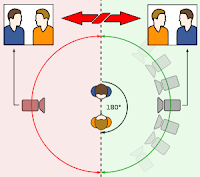
Friday, 27 February 2009
Preliminary Task- The Unknown Object

Friday, 20 February 2009
Micro Drama

- The Villain
- The Donor
- The Helper (Magical)
- The Princess, and her Father
- The Dispatcher
- The Hero or Victim/ Seeker Hero
- False Hero
Thursday, 19 February 2009
Codes and Conventions of Film Openings
In the start of every film, be it before the action starts, after it starts or whilst it is strating, there is always the title sequence of the film. This will tell the audiance who produced the film, the director, and any star actors in the film. It may also tell them of any introducing actors (that they believe will soon be big stars) or any guest appearances.

If the film has a higher budget then they can affoard to have very technical and expensive title scenes that can be used to really show off the staring actors and guest appearances. Usually if this is the case then there will also be music playing in the background that will ever be very popular at the time, or made for the film by a well known singer. This means the film can also be sold through the music industry. For example James Bond's Casino Royale used a very expensive opening to a film that is still well known.

Some film openings if they do not have a massive amount of staring actors or guest appearances will use the start of their film to introduce a character in the film by givng clear signifyers as to what the character is like and what is likley to happen to him throughout the film. An example of this is Trick or Treat, they used the opening scenes by showing gothic products to signify the character was a goth, and also had a voive over of the character talking about his life.
 If a film has a staring role then it is most likley this person will be a central protagonist. This means that throughout the whole movie, the camera will be focused mainly on him/her. If this is so then that actor will get introduced in the opening scene. For example iRobot's central prtagonist was Will Smith, and he was shown on the opening scene.
If a film has a staring role then it is most likley this person will be a central protagonist. This means that throughout the whole movie, the camera will be focused mainly on him/her. If this is so then that actor will get introduced in the opening scene. For example iRobot's central prtagonist was Will Smith, and he was shown on the opening scene.
